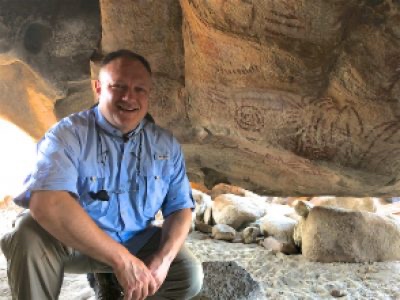Baja Student Reflection: Rob Schultz

By Rob Schultz, Global Field Program graduate student
This past summer I had the opportunity to participate in a Project Dragonfly Earth Expedition to Baja California, Mexico. This was the first of what will be three study abroad classes as part of a graduate program I am working on through Miami University. After initial coursework during the spring months, I suddenly found myself on an airplane heading to San Diego, where I would meet my instructors and classmates for the first time.
After a short orientation meeting, we loaded our gear into vans and departed for Baja. It didn’t take long to determine that this would be nothing short of an amazing adventure. Within a few hours, we were driving through remote desert areas adorned with cacti. It was a whole new world to me.
In the months leading up to our study abroad experience, I had been reading papers about community-based conservation and eco-tourism. I felt as though we were contributing to those philosophies by traveling to Baja as students to study desert and marine ecosystems. Our course was split between Rancho San Gregorio in the heart of Valle de los Cirios Biological Reserve, and the Vermillion Sea Institute in Bahía de los Ángeles on the Sea of Cortez.
Life at the ranch was much more primitive than what most of us were used to. There was no running water, flush toilets or even indoor accommodations. While everyone had been well informed of this ahead of time, it quickly became very real as we started setting our cots in the open air. Over the course of the trip, I quickly began to enjoy sleeping under the desert nights–looking at the stars and milky way overhead.
At the ranch, we learned so much about the desert and the incredible life it holds. Having lived all my life in the northern United States, I had assumed that there was very little life in the desert. Gosh, was I ever wrong! And after a very educational and motivational morning with Raphael, I had a whole new appreciation for the plants that grow in the desert and the many uses they have.
As the oldest student in our class, it had been 26 years since I had been in college and that gap felt significant as I listened to others talking about things that they had studied in their recent coursework. As our expedition went on, I really enjoyed learning with them and being able to challenge myself.
Some highlights included looking for scorpions at night with a black light, an evening class session by headlamp, the early morning hike up the mountain to watch the sun rise over the desert, making a map of the ranch, collecting insects from the ground traps, the moment when it began to rain and the incredible fragrance in the air, and the great discussions we had in the classroom.
I felt very lucky to have two great instructors–Kevin and Linda–who were incredibly thoughtful and encouraging in their instruction style. Kevin challenged us to think differently about things and pressed us to dive deep into our coursework. Linda helped interpret what we were reading when it was a struggle to understand. Both of them complemented each other’s styles and made the course a very rich experience for the students.
Our time at the Vermillion Sea Institute was equally enjoyable and educational. The first night, we experienced the bioluminescence of the red tide that was in the bay. It was incredible to watch the waves light up a greenish-blue color in the darkness. It was an out-of-this-world experience! We learned about ocean-powered islands, studied pelicans, snorkeled, and even hiked on a dormant volcano. I was really excited to be able to see an octopus, stingrays and sea lions up close–our swim with them was one of my favorite memories of the trip!
Daytime was typically spent on the water, exploring the area and observing ocean life. We learned about ocean-powered islands, studied pelicans, snorkeled, and even hiked on a dormant volcano. I was really excited to be able to see an octopus, stingrays and sea lions up close – our swim with them was one of my favorite memories of the trip!
My experience in Baja taught me so much about desert and marine ecology, but even more so, I learned a lot about myself. Being unplugged from technology helped me to reflect on my interests, focus more time on relationships with other students, and immerse myself in our class and what we were studying. I left Baja being more confident in my studies, and much more committed to the important work we must do in helping others understand the fragile environments we live in.
About Rob
Rob Schultz of Minneapolis, Minn., is the executive director of the International Wolf Center. Schultz traveled to Baja as a master’s degree student in Project Dragonfly‘s Global Field Program. In addition to taking online courses, GFP students take Earth Expeditions classes to earn their degrees.
Learn more about our Earth Expeditions course Baja: Field Methods
